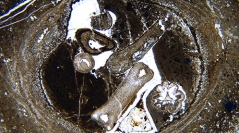

 Geodiversitas
41 (14) - Pages 587-599
Geodiversitas
41 (14) - Pages 587-599Sphenophyllum Brongniart, 1828 is the best-known representative of Sphenophyllales, an extinct order of small plants belonging to the Sphenophytes, the group that contains extant horsetails. Sphenophyllum is known from the Devonian to the Triassic, but most specimens are late Carboniferous in age and the anatomy of specimens present at other times is poorly known because most are preserved in compression/impressions. The Lower Carboniferous (Tournaisian) deposits of Montagne Noire in France and Thuringia in Germany contain impressions attributed to Sphenophyllum but also a few rare permineralized specimens. In this study, we describe in detail the anatomy of these specimens and compare them to other anatomically preserved Sphenophyllum species, as well as to the impressions already described in both areas. The new specimens show different developmental stages, some have a little amount of wood while the others only have primary tissues. Two specimens are branching. All are assigned to Sphenophyllum insigne Williamson. While Late Carboniferous Sphenophyllum produced a wood with a very peculiar anatomy (very large tracheids, axial system of parenchyma), that of the oldest Sphenophyllales (Devonian-Early Carboniferous) seems to be simpler and probably had different hydraulic and mechanical properties.
Tournaisian, anatomy, Sphenophyllales, wood